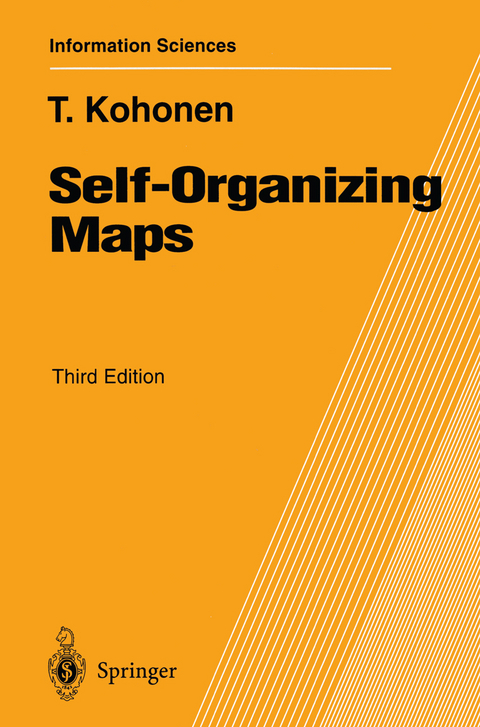
Self-Organizing Maps
Seiten
2000
|
3rd ed. 2001
Springer Berlin (Verlag)
978-3-540-67921-9 (ISBN)
Springer Berlin (Verlag)
978-3-540-67921-9 (ISBN)
The Self-Organizing Map (SOM), with its variants, is the most popular artificial neural network algorithm in the unsupervised learning category. About 4000 research articles on it have appeared in the open literature, and many industrial projects use the SOM as a tool for solving hard real- world problems. Many fields of science have adopted the SOM as a standard analytical tool: in statistics, signal processing, control theory, financial analyses, experimental physics, chemistry and medicine. The SOM solves difficult high-dimensional and nonlinear problems such as feature extraction and classification of images and acoustic patterns, adaptive control of robots, and equalization, demodulation, and error-tolerant transmission of signals in telecommunications. A new area is organization of very large document collections. Last but not least, it may be mentioned that the SOM is one of the most realistic models of the biological brain function.
Since the second edition of this book came out in early 1997, the number of scientific papers published on the Self-Organizing Map (SOM) has increased from about 1500 to some 4000. Also, two special workshops dedicated to the SOM have been organized, not to mention numerous SOM sessions in neural network conferences. In view of this growing interest it was felt desirable to make extensive revisions to this book. They are of the following nature. Statistical pattern analysis has now been approached more carefully than earlier. A more detailed discussion of the eigenvectors and eigenvalues of symmetric matrices, which are the type usually encountered in statistics, has been included in Sect. 1.1.3: also, new probabilistic concepts, such as factor analysis, have been discussed in Sect. 1.3.1. A survey of projection methods (Sect. 1.3.2) has been added, in order to relate the SOM to classical paradigms. Vector Quantization is now discussed in one main section, and derivation of the pointdensity of the codebook vectors using the calculus of variations has been added, in order to familiarize the reader with this otherwise com plicated statistical analysis. It was also felt that the discussion of the neural-modeling philosophy should include a broader perspective of the main issues. A historical review in Sect. 2.2, and the general philosophy in Sects. 2.3, 2.5 and 2.14 are now expected to especially help newcomers to orient themselves better amongst the profusion of contemporary neural models.
Since the second edition of this book came out in early 1997, the number of scientific papers published on the Self-Organizing Map (SOM) has increased from about 1500 to some 4000. Also, two special workshops dedicated to the SOM have been organized, not to mention numerous SOM sessions in neural network conferences. In view of this growing interest it was felt desirable to make extensive revisions to this book. They are of the following nature. Statistical pattern analysis has now been approached more carefully than earlier. A more detailed discussion of the eigenvectors and eigenvalues of symmetric matrices, which are the type usually encountered in statistics, has been included in Sect. 1.1.3: also, new probabilistic concepts, such as factor analysis, have been discussed in Sect. 1.3.1. A survey of projection methods (Sect. 1.3.2) has been added, in order to relate the SOM to classical paradigms. Vector Quantization is now discussed in one main section, and derivation of the pointdensity of the codebook vectors using the calculus of variations has been added, in order to familiarize the reader with this otherwise com plicated statistical analysis. It was also felt that the discussion of the neural-modeling philosophy should include a broader perspective of the main issues. A historical review in Sect. 2.2, and the general philosophy in Sects. 2.3, 2.5 and 2.14 are now expected to especially help newcomers to orient themselves better amongst the profusion of contemporary neural models.
1. Mathematical Preliminaries.- 2. Neural Modeling.- 3. The Basic SOM.- 4. Physiological Interpretation of SOM.- 5. Variants of SOM.- 6. Learning Vector Quantization.- 7. Applications.- 8. Software Tools for SOM.- 9. Hardware for SOM.- 10. An Overview of SOM Literature.- 11. Glossary of "Neural" Terms.- References.
| Erscheint lt. Verlag | 16.11.2000 |
|---|---|
| Reihe/Serie | Springer Series in Information Sciences |
| Zusatzinfo | XX, 502 p. 178 illus., 1 illus. in color. |
| Verlagsort | Berlin |
| Sprache | englisch |
| Maße | 155 x 235 mm |
| Gewicht | 780 g |
| Themenwelt | Mathematik / Informatik ► Informatik ► Theorie / Studium |
| Naturwissenschaften ► Physik / Astronomie ► Astronomie / Astrophysik | |
| Naturwissenschaften ► Physik / Astronomie ► Theoretische Physik | |
| Naturwissenschaften ► Physik / Astronomie ► Thermodynamik | |
| Schlagworte | Adaptive and Learning Networks • Adaptive und Lernende Netze • cluster analysis • CON_D044 • Klassifikator • Klusteranalyse • Lernen ohne Lehrer • Mustererkennung • Neural networks • Neuronale Netze • pattern recognition • Selbstlernen • Selbstorganisation • Selbstorganisierende Karten • self-organizing m • Self-Organizing Maps • Unsupervised Learning |
| ISBN-10 | 3-540-67921-9 / 3540679219 |
| ISBN-13 | 978-3-540-67921-9 / 9783540679219 |
| Zustand | Neuware |
| Haben Sie eine Frage zum Produkt? |
Mehr entdecken
aus dem Bereich
aus dem Bereich
Buch | Hardcover (2012)
Westermann Schulbuchverlag
CHF 44,90
Schulbuch Klassen 7/8 (G9)
Buch | Hardcover (2015)
Klett (Verlag)
CHF 29,90
Buch | Softcover (2004)
Cornelsen Verlag
CHF 23,90


